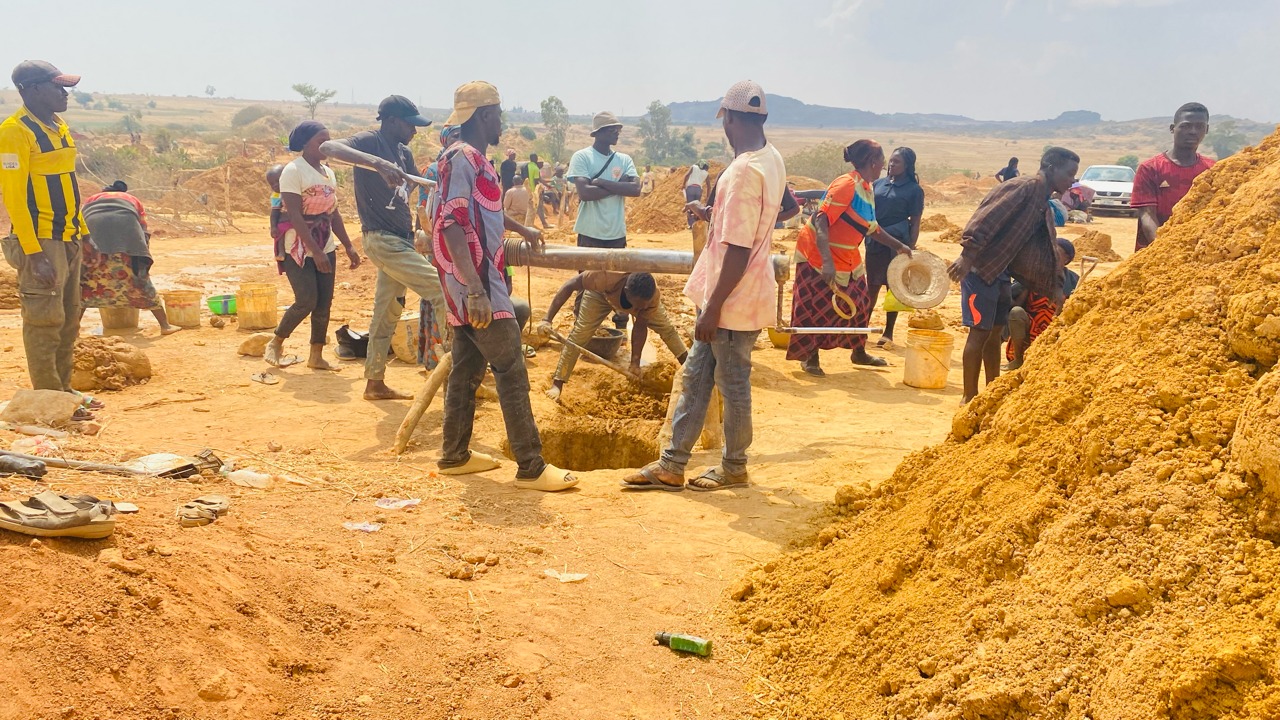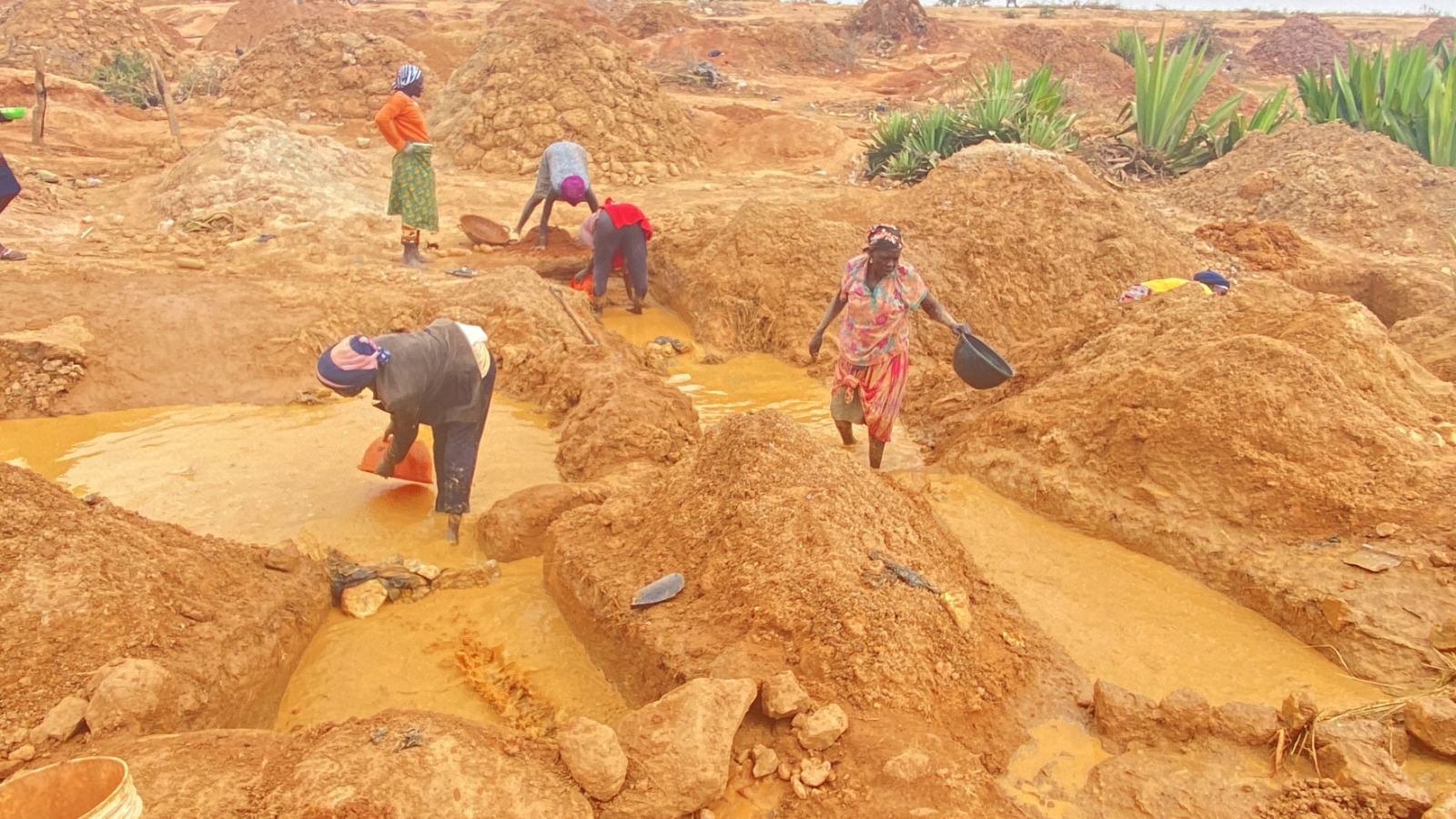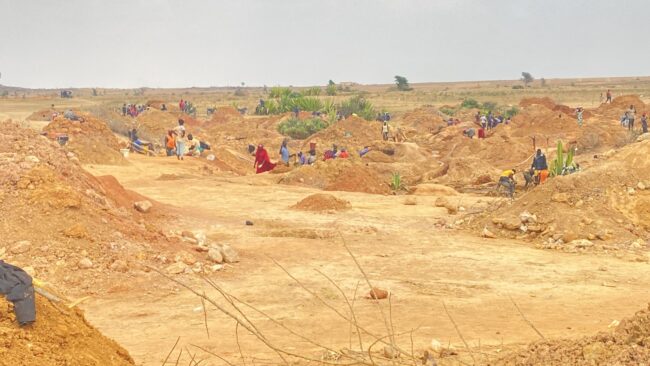Jos, the Plateau State capital, is known as the Tin City. Nigeria began tin mining there, and the nation profited greatly from it. Decades after the mining stopped, indigenous communities in the state are still reeling from the impacts. JUSTICE NWAFOR investigates the impacts of tin mining on indigenous communities in Plateau State in this two-part series. The FIRST PART investigated the impacts on agriculture and farmers.This second part investigates the impacts on the health of residents.
For the communities of Chugwi and Kewa-Bisichi, which are about 15 kilometres from Jos, Plateau State, in northern Nigeria, mining activities of the past and present have merged to impact locals. In this area, extensive tin mining occurred in the early to mid-20th century, devastating the environment and causing harm to the health of residents. Now, the situation is being compounded by the activities of artisanal or small-scale illegal miners.
Fifty-two-year-old Cordelia Emmanuel has spent most of the last 10 years working at various illegal mining sites throughout the state. But for the last two years, she has been working at one of the largest illegal mining sites in Kewa-Bisichi.

Cordelia’s routine includes packing the dug-up sand dumped near the pit into leather bags and transporting it to the point where the sieving for tin extraction begins. She would walk for nearly a kilometre with the bag of sand on her head.
“Sometimes when there are a lot of people to pack, I would beg our boss to allow me to join the people who would wash the sand for tin,” Cordelia told the Nigerian Tribune.
She works every day except Sundays, which exposes her to tin on a regular basis. She said she was not concerned about the effects of her exposure. Her top priorities are making sure her kids have enough to eat and are not expelled from school for failing to pay the required fees.
The US CDC says that, in addition to regular stress, repeated exposure to tin has detrimental effects on people’s health and may cause issues like stomach aches, anaemia, liver issues, and kidney problems.

Working continuously in the mines, as Cordelia does, exposes one to chemical byproducts of tin mining like monazite, pyrochlore, and xenotime that can lead to health issues like coughing, weight loss, bloody sputum, difficulty in breathing, weakness, bluish skin tone, lung damage, and heart conditions. According to a U.S. Department of Energy Safety Data Sheet, this exposure could also result in cataracts, anaemia, and cancer.
Cordelia is unaware of the extent of the dangers she is exposed to on a daily basis.
She can’t link some of her health issues to her repeated exposure at the site, but in February 2022 her symptoms were eerily similar to those linked to tin exposure.

“In February last year, I was so terribly sick that my brother had to take me to his house in Jos,” she said. “It was difficult for me to breathe well, and sometimes, when I vomited, there were traces of blood in the saliva. I spent about four days at the hospital, and the doctor asked me to stop this kosa (mining) thing I am doing. But it’s not easy. If I stop it, who will feed my children?”
People who are exposed, like Cordelia, might face a bleak future. Dr Golibe Ugochukwu, a medical doctor and public health expert, told the Nigerian Tribune that the manifestation of the symptoms of the disease that could keep people like Cordelia down may take many years. “It can take years or even decades of regular exposure for (respiratory) conditions like silicosis to manifest and become clinically apparent,” he said.
Not just in Plateau State but all over the country, there are thousands of men and women like Cordelia. Although there is no current, official data on the number of artisanal tin miners in Plateau State, a report from the Nigerian Extractive Industry Transparency Initiative (NEITI) from 2021 states that 1,273 Artisanal and Small-scale Miners (ASMs) operated in the nation in 2020.

The report states that the number was comprised of ASMs across the six geographical regions of the nation. North-central, which includes Plateau, had the highest number (355) of any of the country’s geographic regions. There were 146 in the south-south, 170 in the south-east, 182 in the south-west, and 236 in the north-west.
Also, up to 85 percent of the miners in Nigeria are artisanal and illegal operators who do not adhere to safety standards and environmental regulations like wearing personal protective gear, proper handling and disposal of hazardous materials, and implementing measures such as reclamation and rehabilitation of mining sites.
Heavy health impacts
A scientist at the South African Medical Research Council with extensive experience in environmental health, Dr. Vusumuzi Nkosi, has studied the effects of mining on health in great detail. He explained to the Nigerian Tribune that there are several ways for someone to become exposed to heavy metals, and the method of exposure determines the potential health effects.
For instance, long-term exposure can result in lung problems if the exposure occurs through breathing (respiratory pathway), and a person may experience symptoms like persistent coughing or wheezing and shortness of breath, he said.

According to him, residents of remote communities like Kewa-Bisichi, where access to high-quality medical care is scarce and many residents suffer from underlying medical conditions like asthma, are frequently affected by this exposure. The elderly and children, he continued, are particularly at risk because “their immune systems are not that strong to protect them from illnesses, and the elderly are ageing and their lung capacities are declining.”
Breathing in dust from crystalline silica-containing materials, one of the substances that people are exposed to during the tin mining process can lead to silicosis, a situation in which silica dust particles become trapped in lung tissue, causing inflammation and scarring. The particles reduce the lungs’ ability to take in oxygen. Silicosis results in permanent lung damage and is a progressive, debilitating, and sometimes fatal disease, the CDC says.

“Chronic silicosis typically occurs after 10 or more years of exposure to respirable crystalline silica. However, the disease can occur much more quickly after heavy exposure,” said Dr Golibe.
Silicosis manifests as coughing, fatigue, shortness of breath, and chest pain, according to the CDC. It also explained that there is no cure for silicosis; some patients may require lung transplantation, and people exposed to silica and those who have silicosis are also at increased risk of tuberculosis. The National Cancer Institute has also linked exposure to respirable crystalline silica with elevated rates of lung cancer. This means people who are exposed are likely to be affected by lung cancer, said Dr Golibe.
According to Dr Nkosi, ingesting contaminated food is the second method of exposure. Because of this, they will likely suffer from anemia, chronic diarrhea, liver and kidney disease, and stomach aches as a result of eating contaminated food.
The third is exposure through physical contact: when they get into contact with this, they are exposed to toxic substances that can lead to skin allergies, skin conditions, and contact dermatitis.
Death at the backyard
Sixty-three-year-old Elizabeth Ishaya does not have to leave her home in order to be exposed to the dangers of tin. A tin mining pit and mounds of mine tailings are just a few steps from her mud-built two-bedroom home in Chugwi, which is about 12 kilometers south of Jos.
Elizabeth and her husband made the decision to move from her husband’s brother’s house a few years ago, and the space that was open to them was just a few meters from an old mine pit and a few new small ones.

When the Nigerian Tribune visited Elizabeth’s home, artisanal mining was ongoing just in her backyard, and the tailings dug up from the pit were dumped indiscriminately near her house.
“That’s the sand from the pit,” Elizabeth said, pointing to the tailings. “We used some of the sand when we were building our house.”
She is not the only one who used mine tailings to build houses where they live and sleep in the community. The Nigerian Tribune found that due to the endemic poverty and the high cost of cement, residents of the community who build their houses near places where artisanal mining still takes place would see the new tailings as an available resource for their houses.
But experts have warned that living near mine tailings is hazardous. In 2015, Prof. Charles Egbu Odita of the School of the Built Environment, Salford University, Salford, Samuel Danjuma Wapwera, and Grace Mebi Ayanbimpe, both of the University of Jos, studied the impact of the tin-mining activities due to the presence of heavy metals and radioactive substances in Jos. They analyzed the level and availability of some radioactive substances (X-ray, beta-ray and gamma-ray) and the presence of heavy metals in housing, water, air and soil.
“The results show that there are traces of X-ray, beta-ray and gamma-ray as well as heavy metals such as lead, arsenic, copper, chromium and nickel, which exceeded the international standards,” the researchers said. “This is particularly significant as people use the contaminated soils as building materials for their homes as well as for farming and food production.”
The researchers explained that the “effects of the decay and emission of radionuclides, exemplified in the use of tailings in building construction, can trigger radioactivity in buildings.”
They noted that ionizing radiation may cause injuries to the brain, damage to the eye lens resulting in cataracts, damage to the ovaries or testes, which may cause infertility, and damage to the bone marrow, which affects the body’s ability to fight infection. Alpha and beta gamma radiation particles are dangerous radioactive materials when taken into the body following exposure.
“In addition to the radioactive elements identified in the tailings, manganese, iron, lead, cadmium and zinc were also detected during chemical analysis,” the researchers said.
Samuel Daniel teaches radiation and health physics at the University of Ibadan, southwest Nigeria. He told the Nigerian Tribune that it is concerning that people do not understand that exposure to tin mining sites has grave dangers and that radioactive elements are evident in the environment.
“That people do not understand the hazards is a very big problem,” Samuel said. “There’s a high probability of lung cancer” for those repeatedly exposed. “Radon can cause lung cancer as well as stomach cancer, but lung cancer is more prominent,” said Samuel.
Old mine sites and slow poisoning
For the residents of mining communities, it is a double whammy. Studies have shown that the effects of large-scale mining that occurred decades ago still have a significant impact on the health of the locals, in addition to the unregulated small-scale mining by locals. In these communities, agriculture is a main source of income for many.
Largely during the dry season, the farmers look for water sources to irrigate their farms, and they look to ponds formed in old, large mine pits.
For instance, at the artisanal mine site in Kewa-Bisichi, water for tin washing and sieving is drawn from a pond at an old abandoned mine site that is a few meters away. The used water from the site also finds a way to settle back into the pond. From this same pond, nearly all farms in the area are irrigated.
So, in 2019, researchers at the University of Jos (Afuyai G. M, Eneji I. S, Sha’Ato R and Nnamonu L. A) studied the impacts of using such contaminated water to irrigate vegetable farms near the Kewa-Bisichi site and found the results to be very disturbing.
“The concentrations of lead, cadmium, chromium, arsenic and manganese in the edible vegetables were above the safe limits prescribed by FAO/WHO, 2007 and the EU, 2002 for all studied vegetables,” the study explained, noting that “the results indicated a potential pathway of human exposure to slow poisoning by heavy metals due to the utilisation of vegetables grown on heavy metal contaminated soil that was irrigated with tin mining pond water sources.”
“Thus, the consumption of these vegetables might pose substantial health risks to consumers,” the researchers warned.
These findings resonate with the fears of Dr Nkosi: “It is not a matter of what dose you are exposed to or what concentration levels you are exposed to. These are toxic metals, and studies have shown that even at very low concentration levels, exposure to these toxic metals makes a person more likely, especially children and the elderly, to experience adverse health outcomes.”
Indigenous Berom people
Berom people make up nearly half of Plateau State’s population, according to unofficial statistics.
Kewa-Bisichi and Chugwi are both of the indigenous Berom group, located in Barkin Ladi and Jos South Local Government Areas, respectively.
With an estimated population of 1.3 million, the Berom indigenous group is the largest indigenous ethnic group in Plateau State. Four local government areas—Jos North, Jos South, Barkin Ladi and Riyom—are home to the Berom people. Additionally, they have spread to some local government areas in southern Kaduna State, such as Fadan Karshe, with Berom settlers there tracing their lineage to Za’ang (Zawan), a Berom district on the Jos Plateau.
Da-Atyos Mandung is the Gwom (traditional ruler) of Chugwi community. He told the Nigerian Tribune that the impact of mining on the community has eroded life as it was known to the Chugwi community and the Berom indigenous group.
“There’s hardly a day we don’t get complaints from people who have either fallen into deep mine pits and died in the farms or even close to their house or who get sick unusually often. There are ponds with dirty water that children swim in and drown in,” Mandung said.
Nigeria enacts law to fix the problem
While the problems are dire and locals are heavily affected, the Nigerian government has taken steps to fix them.
The Minerals and Mining Act, passed by the Nigerian government in 2007, established a requirement for ongoing reclamation of mining land to be carried out concurrently with mining operations. According to the law, mining companies with operating licenses were required to establish a reserve fund to cover expenses for environmental safeguards, mine rehabilitation, reclamation, and closure.
Section 30 of the law emphasizes that “a tax-deductible reserve for environmental protection, mine rehabilitation, reclamation, and mine closure costs shall be established by companies engaged in the exploitation of mineral resources.”
However, implementation has been problematic, largely because large-scale mining occurred before the law was passed and because the majority of small-scale miners in Plateau State operate illegally.
The attempt to address the issues dates back to 1955, when the government at the time reclaimed abandoned mining sites run by the Northern Regional Government. Reclamation entails repairing wildlife habitats, removing office buildings, processing facilities, and transportation equipment, as well as sealing mine shafts and other openings. It also includes filling hollows with soil or rock removed during excavation and planting trees to stabilize and restore the mined area. The efforts would continue in 1980 with the reclamation of several sites across the country.
In 2017, there was an increase in efforts. At the time, the Ministry of Mines and Steel Development (MMSD)estimated that it would cost N1.67 trillion to reclaim more than 1,600 defunct mine sites throughout the nation and would later announce that between 2007 and 2019, it spent N2.39 billion to reclaim 32 mining sites across the country.
Again, last year, Vivian Okono, the Director of the Mines and Environmental Compliance Department at MMSD,claimed the government reclaimed 37 abandoned mining sites in the country between 2008 and 2022. She added that six more were to be reclaimed last year, with Plateau listed as one of the beneficiary states.
Pirfa Jingfa Tyem is a lawmaker in the Plateau State House of Assembly. He told the Nigerian Tribune that illegal mining is a complex problem in the state and that fixing it would require a multi-dimensional approach.
“The moment you try to make them (artisanal miners) understand the impacts of their activities, there is so much resistance. For moral reasons, the state government has kept quiet because, for most of the miners, that is where they feed from. If you ask them to stop, they’ll ask you to provide alternatives—which are not available—for them,” the lawmaker said.
Beyond the challenges, Tyem said the miners have been told to form groups to enable them to access funds to help them get the right equipment for mining. “The state government has done well in making the registration process for artisanal miners easy,” Tyem said. But miners like Gyang Davou, the head of the miners’ union at the illegal mine where Cordelia works at Kewa-Bisichi, say the process is not yet as simple as it should be to enable them to register seamlessly.
Tyem explained that the miners have been advised to form groups (cooperative organizations) so they can source funding facilities from banks. They could, as cooperative organizations, approach the government and demand low-interest or interest-free credit facilities to help them improve, get the equipment to make their activities better, and register, Tyem said.
The Nigeria Mining Cadastre Office did not respond to emails for comments.
Sustainable solution: The tripartite approach
Resolving the problem so indigenous communities in the affected area can lead a better life requires more than one approach, says Dr Nkosi. He advocates a tripartite approach that would involve the government, the mining companies/illegal miners and the community residents.
The first step is for the government to enact and implement laws to protect the environment and the host mining communities: “The government has to formulate legislation, implement it, come up with buffer zones, and monitor compliance among mining companies. This will ensure communities are protected,” he said.
The creation of jobs is a key component of the government’s role in this three-pronged strategy. Just as Cordelia said she works at the illegal mine site due to a lack of employment opportunities, Dr Nkosi argued that if the government is serious about reducing illegal small-scale mining, it must offer miners economic opportunities and establish a platform to regularize them. He said: “People will turn to informal (illegal) mining due to a lack of employment. Formalizing them will also help boost the economies of the local communities. If the government fails to play its role, the problem will persist.”
Cordelia agrees that the provision of employment opportunities will reduce the rate of illegal mining in Plateau State. She clarified that, if she finds another job that will enable her to support her family, she will stop working at the illegal mine site, and says others at the site will do the same.
The miners and mining companies make up the second aspect of the strategy. The miners have an obligation to answer to the government and abide by the law. In the case of Plateau, where the companies (like Jos Tin Mining Company, Nigerian Tin Ore Mining Company, Amalgamated Tin Mines of Nigeria, and Ropp Tin Mines) left in the 1980s and 1990s, the government failed to hold them accountable at the time. According to Dr Nkosi, the illegal miners must also be held accountable. He advises them to get formalized, registered, trained and equipped with the appropriate protective gear before beginning their operations so that they minimize the risks to the environment and the host community.
To the former National Chairman of the Progressive Miners Association, Mr Sunday Ekozin, the government should do more to regulate the operations of illegal miners. He told the Nigerian Tribune in an earlier reportthat the government should “buy mining equipment (for the illegal miners) as a way of generating employment and empowering them.” He explained further: “The government needs to come in. There is no passion to drive the sector, and genuine miners are frustrated. Without fundamental restructuring, illegal mining will continue to strive.”
Local communities play a critical role too. According to Dr Nkosi, communities are typically the ones who suffer and should make an effort to comprehend the effects of exposure and how to protect themselves. “Part of the duties of the communities is to engage with the government, collaborate and come up with innovative solutions as to how to protect themselves and mitigate the effects of the problem,” said Dr Nkosi.
For Mandung, the traditional ruler of Chugwi, the illegal mining problem revolves around the unemployment of his people, and fixing it would mean fixing the unemployment first. “When you talk to them about stopping, they will tell you to give them another job. I am sure if you give them meaningful employment, they will stop.”
This story was produced with support from Internews’ Earth Journalism Network




